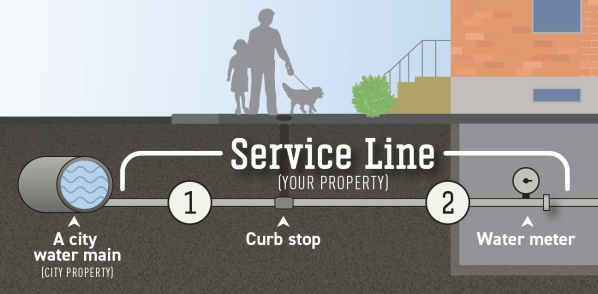Service Line Material Map
Use this map to see our current records of materials in your water service line. Learn what you should do based on your material. Residential water service lines in Philadelphia are owned entirely by the property owner.
What you will find on this page:
- An interactive map to check your service line material
- Information for each service line material
- Guidance on how to keep your water safe
- Additional resources
Find out how your service line material is categorized
How to use the map:
- Click the checkbox and “View the map” button to agree to the disclaimer.
- Enter your address into the map search bar.
- Read the pop-up box for details about your property.
Please note: “Incomplete records” should be treated as a lead service line for your health and safety.
Incomplete records were previously called “Unknown”.
Questions, issues, or updates?
If you have had your service line replaced, checked the material at your meter, or believe our records are incorrect:
If you are having trouble using the map, can’t find your property, or have another question or feedback:
The data in this map is compiled from multiple sources. Sources include historical records, field inspections, permits, and material tests of one section of the service line during meter upgrades. These records will be updated over time as we gather additional information. We reserve the right to alter, amend, or stop the display of these maps and records at any time. We are required by state and federal law to make these records available to the public.
Understanding your Service Line
To assess the overall service line material, PWD reviews material information from two points along your service line. Based on the PWD’s current records, the property map look-up tool will indicate the material make-up of your service line:
- Material in the section between Main and Curb Stop: Portion of the service line closest to the street
- Material in the section between Curb Stop and Meter: Portion of the service line closest to the property

As material can differ along the length of the service line, PWD evaluates the material combination at each property, and determines the service line overall material status. To categorize the service line as Non-lead, PWD must verify the service line material type along at least two points of the service line. *
If the map indicates that you have a lead service line, visit the Lead Plumbing & Water Quality page for more information on reducing lead exposure and replacing your lead service.
* Service line categorization meets the Pennsylvania Department of Environmental Protection criteria.
Learn how we keep your water safe from lead
Water Service Line Materials
The materials of your water service line matter. Learn what you can do to keep your drinking water safe.
Remember: Service lines in Philadelphia belong to the property owner.
Lead
Lead was used in the past because it is soft and can be bent. Lead service line installation decreased after the 1950s as harmful health effects became clear.
Having lead pipes does not necessarily mean you have lead poisoning or significant health complications from lead. However, it is important to take steps to reduce potential exposure.
Learn more about lead service lines →
Galvanized Metal
Galvanized metal pipes can corrode. Over decades, any lead from a property’s plumbing can accumulate on the corroded walls of galvanized pipes.
Learn more about galvanized service lines →
Incomplete Records
Many service lines are categorized like this if we have partial or incomplete records for the service line material. Previously, we referred to these lines as “unknowns”.
Learn more about incomplete records →
Non-lead
If your service line is categorized as “non-lead”, it is likely made of plastic or copper. These materials are commonly used because they do not contain lead. Learn more about non-lead service lines →
You can request a water test
If you have specific concerns about lead in your drinking water, you can request a free water test from the Philadelphia Water Department to check the levels at your tap. Learn more and request a test →
Why did we create this map?
Old lead service lines are a challenge across the country. Even though these lines don’t belong to the City of Philadelphia, we are committed to supporting the removal of water service lines that contain lead. To meet this challenge, cities need to understand the number and location of these lines. The map and records will inform plans for future lead service line replacement efforts.
It’s the law: We’re required by Federal and State law to make this information available to the public. This law applies to every water utility in the United States. There is a national effort to remove lead service lines from all properties. Sharing this information is a key step in this important work.
Where did the map information come from?
The information is compiled from multiple sources. Sources include historical records, field inspections, permits, and material tests of one point of the service line during meter upgrades or conservation assistance.
However, no materials identification method is 100% accurate.
Further work may be required to confirm and verify the materials at more points along a service line.